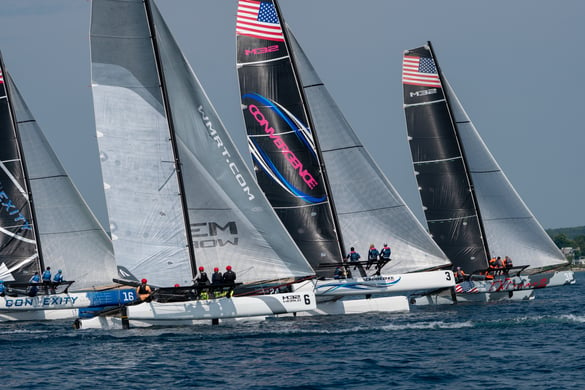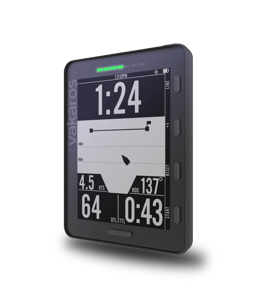Start first, and extend.

The Atlas 2 takes starting one step further and collects data to help you get off the line as best as possible. Not only does the A2 read out distance-to-line, but also highly accurate time-to-line. This SailGP and America's Cup level technology in an affordable instrument is revolutionary.
Want to learn how the pros are getting off the line with Vakaros? Read on. Like most great decisions, great starts are informed first by data collection.
Data Collection - Prestart
You've hit the course and are tuning up. The Atlas 2 Shift Tracking feature will guide you through a short upwind leg designed to see what angles you're sailing, how consistent those angles are, and how they may change. The Atlas 2 will show you your tacking angle, upwind bearing, and average speed. All this info will come in handy during the rest of the race, too.
The RC tells you that both ends of the line are set. Ping them, using the BOAT and PIN buttons on the starting screen. You can repeat these pings as many times as you like. Your Atlas 2 will immediately display the line length, perpendicular bearing, and if you activated your shift tracking, the line bias. Also, your Distance to Line will be displayed, calculated using a bow offset programmed into the Vakaros Connect App.
During the Sequence: T-minus 5 Minutes

Press the 'Start' button to start the timer feature on your device. You can hit the 'sync' button to hone in on the perfect time as the sequence goes on. Your Atlas 2 will display a graphical starting layout, designed to keep everyone on your starting team informed. Our Time-To-Line algorithm will use the speeds you calculated earlier in Shift Tracking to judge the time to sail back to the line. The start is soon: find your hole, trust the Atlas' data, and start first. Your Atlas 2 will switch back to its custom racing screen with all the data you want. After that? Buddy would say to extend, and we know how to do just that. Stay tuned for more insights on how to get the most out of your first leg with Vakaros.
How accurate is the Vakaros Atlas 2?
In short, very. The Atlas 2's industry leading L1+L5 GNSS receiver allows for 30 cm accuracy with little to no ionosphere error. No instrument with starting aids can boast as accurate and precise a GPS sensor package. And, no comparable instrument combines Distance-To-Line and Time-To-Line with an intuitive starting graphic. In short, the Atlas 2's abilities as a starting aid are unrivaled.
Teams have found that the Atlas 2 is so spot on, they can trust it to determine whether they were over OCS even before hearing a Race Committee recall. They've saved previous seconds in returning below the line, restarting, and working to claw back.
"We made an error and were over the line early. Our trust in the Atlas 2 was so high, we turned back before being called by the RC, cleared ourselves, and recovered to a third in a fleet of 40. Any delay would've been costly, but the A2 let us know instantly."
R.J. Porter, 2x Melges 17 National Champion
The best sailors in the World are no longer leaving starting to chance: they trust the Atlas 2 to help them get off the line cleanly and hit the first shift. So, take a step towards improving your starting game and check out the Atlas 2 here.
Want to know more about what the Atlas 2 can do? Leave a comment with a feature you'd like explained, and it could be the topic of our next Atlas Tech Talk Blog!
